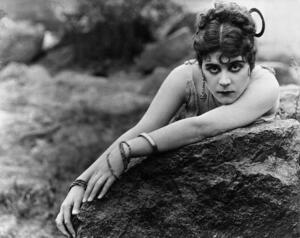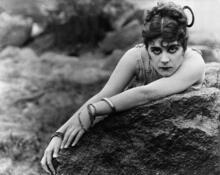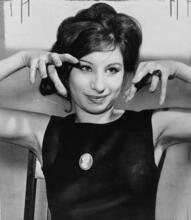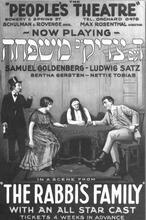Theda Bara
Theda Bara became an icon of sensuality and the exotic for generations. Born Theodosia Goodman, she began working in New York with her own name before she was cast as a vampire seductress in A Fool There Was. Fox Film executives changed her name and gave her an exotic origin story. Bara’s magnetic performance made her an overnight success; between 1915 and 1919 she starred in over forty films. Bara’s dark exoticism and the veils and bangles she wore helped create the archetype of the seductive vamp, but her career was short-lived—as American tastes changed, Bara was passed over in favor of more “wholesome” starlets. A 1937 fire at the Fox Film vaults destroyed most of her movies, yet she endures as a cinematic icon.
Long before Mae West, Greta Garbo, Marlene Dietrich, Jean Harlowe, and Madonna vamped their way across the silver screen, there was Theda Bara—the original celluloid “vamp.”
Early Life and Family
Born Theodosia Goodman on July 29, 1885, in Cincinnati, she was the daughter of Bernard Goodman, a Jewish tailor from Chorsel, Poland, and Pauline Louise Françoise de Coppet, who was Swiss of French descent. Bara had an older brother named Marque and a younger sister named Lori.
Rise to Stardom
At age eighteen, she decided to become an actor and moved to New York City. Seven years later, she became known throughout the country as the sex goddess of the silent screen. Between 1915 and 1919, she starred in forty films as a deadly seductress, ushering in the age of the “vamp,” a word that came to be used as both noun and verb. In movies with such titles as Sin, Destruction, The Serpent, Salome, and Cleopatra, she played exotic and wicked characters who lured helpless men to their ruin.
Her fame began in 1915 when director Frank Powell discovered her and asked her to star in a Fox Film Company production titled A Fool There Was. Realizing that her career on the stage was not progressing, she reluctantly accepted. Concerned about casting an unknown actor alongside the well-known Broadway star Edward Jose, William Fox, head of Fox Film Company, staged the first-ever sensationalized publicity campaign. Fox’s press agents promptly changed Theodosia Goodman’s name and origins. “Theda Bara,” they announced, was an anagram for “Arab Death.” Born in the shadow of the Sphinx, they claimed, she was the daughter of a French artist and his Arabian mistress. In reality, Theda was a contraction of Theodosia, and Bara came from her maternal grandfather’s name, François Baranger de Coppet.
A Fool There Was was based on Porter Emerson Browne’s 1909 stage melodrama, which in turn was based on Rudyard Kipling’s poem “The Vampire.” Kipling had been inspired by Sir Edward Burne-Jones’s painting of the same name. The story revolved around a temptress who squeezed everything out of men—money, dignity, and finally life itself.
Bara’s Exotic Image
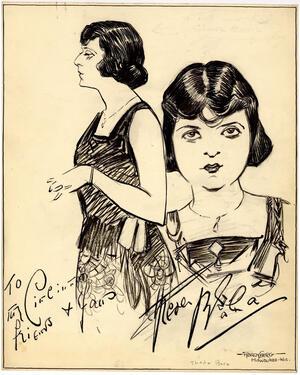
Signed drawing of actress Theda Bara, by Manuel Rosenberg, illustrator, cartoonist, writer, editor, and publisher and from 1917 to 1930 chief artist for the Scripps-Howard chain of newspapers and art editor of the Cincinnati Post. Courtesy of Anita Rosenberg.
Little did Fox have to worry about casting the unknown Bara—she was an overnight sensation. The New York Dramatic Mirror wrote: “Miss Bara misses no chance for sensuous appeal in her portrayal of the Vampire. She is a horribly fascinating woman, vicious to the core, and cruel. When she says ‘Kiss me, my fool,’ the fool is generally ready to obey and enjoy a prolonged moment, irrespective of the less enjoyable ones to follow.”
Her large black eyes, accentuated by heavy kohl makeup, set off her rounded, dead-white face. Elaborate props such as a tiger-skin rug and a long gold cigarette holder embellished her exoticism, as did her penchant for veils, crowns, large hoop earrings, and bronze bangles. With her long, dark hair and voluptuous figure draped in low-cut gauzy gowns, the vamp perpetuated a familiar stereotype of European passion and exoticism. At the same time, the character created a popular image of women as sensual yet powerful. The vamp dominated and triumphed over men, and contrasted sharply with the clean-cut WASPish characters portrayed by Mary Pickford and Lillian Gish.
Bara scandalized the mores of the middle classes. Meetings held across the country put the burgeoning film industry on trial and focused on Theda Bara—the vampire, the wickedest woman in the world, as she was billed by Fox. Of one film, a critic wrote, “Were the National Board of Censorship possessed of any judgment whatsoever, this is the kind of picture it should place the ban of its disapproval upon.” Local boards issued edicts condemning her films.
But her popularity was unstoppable. In 1915 alone, she starred in eleven pictures. Labeled “Hell’s Handmaiden,” she received two hundred letters a day, including over a thousand marriage proposals. Adoring fans named their babies after her. Her movies ran continuously, sometimes playing six times a day.
Some fans failed to distinguish Bara from her fictionalized roles. One bitter moviegoer wrote, “It is such women as you who break up happy homes.” Bara replied, “I am working for my living, dear friend, and if I were the kind of woman you seem to think I am, I wouldn’t have to.” Another, a criminal defendant, claimed that he killed his mother-in-law after viewing one of Bara’s films.
Bara defended her role: “The vampire that I play is the vengeance of my sex upon its exploiters. You see, I have the face of a vampire, but the heart of a feministe.” But she also worried about the image she perpetuated: “I try to show the world how attractive sin may be, how very beautiful so that one must be always on the lookout and know evil even in disguise.” Besides, she added, “Whenever I try to be a nice, good little thing, you all stay away from my pictures.”
Later Life and Legacy
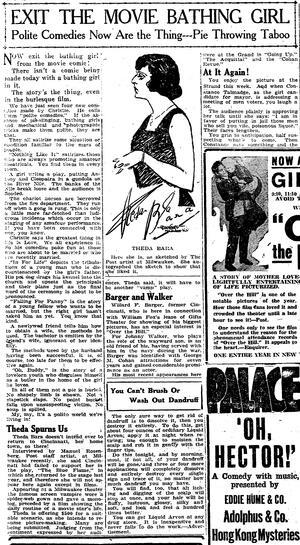
News clipping from the Cincinnati Post, "Exit the Movie Bathing Girl: Polite Comedies Now Are the Thing -- Pie Throwing Taboo," with drawing of actress Theda Bara by Manuel Rosenberg, illustrator, cartoonist, writer, editor, and publisher and from 1917 to 1930 chief artist for the Scripps-Howard chain of newspapers and art editor of the Cincinnati Post. Courtesy of Anita Rosenberg.
Fox refused to renew her contract after 1919. More significantly, by 1920 the movie industry had reached a larger public. Filmmakers such as Cecil B. DeMille cleaned up the vamp image for a wider audience. No longer menacing or mysterious, stars like Clara Bow and Louise Brooks exuded a cleaner image of sex and sexuality.
After 1919, Bara did some stage work and starred in two more films in 1925 and 1926. In 1921, she married director Charles Brabin. Their marriage lasted until her death on April 7, 1955. Theda Bara created, with her characterization of the vamp, a seminal and enduring image of female sexuality in American popular culture. Tragically, A Fool There Was is the only one of her films that survived intact.
AJYB 24: 117.
Bodeen, Dewitt. “Theda Bara: The Screen’s First Publicity-made Star Was a Woman of Sensibility.” Films in Review 19 (May 1968): 266–287.
DAB 5.
Ewen, Elizabeth. Immigrant Women in the Land of Dollars (1985).
Koszarski, Richard. An Evening’s Entertainment: The Age of the Silent Feature Picture, 1915–1928. In History of American Cinema Series. Vol. 3 (1990).
MacCann, Richard Dyer. The Stars Appear (1992).
NAW modern.
Obituary. NYTimes, April 8, 1955.
Zierold, Norman. Sex Goddesses of the Silent Screen (1973).

